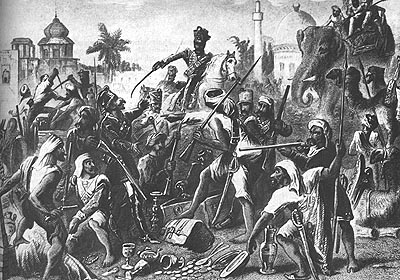
Sergeant John Wighton and the 72nd arrived in India in January 1858. The mutiny had started in May of the previous year and when the 72nd arrived, the British were on the offensive. Following is a brief summary of notable events during that period.
The roots of the Sepoy Mutiny arose long before May 1857 when the first shots were fired. From the Indian perspective, the causes were a direct result of the cultural and religious oppression imposed on them by British rule. The East India Company was a massive export company that was the force behind much of the colonization of India. By 1848, the Company was experiencing financial difficulties. To expand its revenue, it needed to expand the size of British territories in South Asia so it began to annex the land of native princes. In order to consolidate and control these new holdings, a well-established army of 200,000 Indians officered by 40,000 British soldiers dominated India by 1857.
Historian trace the origins of the rebellion to the Lee-Enfield Rifle whose cartridge had to be manually loaded before firing. Loading involved biting the end of the cartridge, which was greased in pig fat and beef tallow. This presented a problem for native soldiers, as pig fat is a forbidden substance to Muslims, and beef fat is banned for certain Hindus. The Indian soldiers interpreted the regulations as part of a plot to force them to adopt Christianity. Thus, the revolt occurred as a reaction to this particular intrusion into Hindu and Muslim culture, and then caught on as a national rebellion.
Other historians argue that the issues with the rifle were but the last straw for Indians who had been victims of British cultural and class-based oppression and antagonism. For them, the root causes of the insurgency cannot be traced to a single, well-defined set of events and causes, but rather arose from an on-going set of conflicts stemming from the imposition of Western ideas on an Eastern people. The Sepoy soldiers found themselves constantly pitted against their countrymen in an army governed by what common soldiers came to feel were outside influences. Indian unrest was also intensified by the Company's annexations of over 250,000 square miles-- an area three times the size of England and Ireland. In doing so, the Company destroyed dynasties with a scratch of a quill and heaped indignities on Indian royalty. Participating in the military conquest of local authorities, then, and having first-hand knowledge of the effects of British expansionism fomented resistance in the Sepoys.
The powder keg was ignited on May 9th, 1857 when a regiment of Indian troops refused to put the Lee-Enfield cartridges into their mouths. They were imprisoned and were due to be sentenced when they broke ranks, turned on their commanding officers, and killed them. Chaos ensued and the rebels engaged the British troops in the vicinity. Emboldened by the support of other Indian regiments, the sepoys captured Delhi. Violence against the British spread rapidly throughout North and Central India. Initially, the rebels, although divided and uncoordinated, gained the upper hand, while the unprepared British were paralyzed without adequate forces and without replacements for the casualties. (Indians constituted 96% of the 300,000 British Army in the country.)
In response, the British moved regiments from the Crimean War to India. The British were slow to strike back at first but eventually two columns left Meerut and Simla (Britain's North India base where John Wighton would spend 5 years from 1860-1865). By September 1857, the back of the rebellion was broken with the British recapture of Delhi. Hostilities continued that fall with the army relieving the Indian siege of Lucknow and retaking Kanpur.
The final stage of the mutiny took place in Central India which was aroused by a roving army of rebels under Tantia Topi who succeeded in capturing Gwalior, the strongest fortress in Central India in 1857. The Central India Field Force, consisting of two brigades, was constituted in January 1858 to deal with these rebels. The Force captured Gwalior, the last major sepoy fortress, in May 1858. From June 22, 1858 to April 7, 1859 the British forces pursued Tantia Topi all over Central India and eventually captured him. The remaining rebels fled into Nepal and the conflict was over. It was a crude and brutal war, with both sides guilty of atrocities.
Sources
Various web sites, including:
The Central India Campaign: http://defencejournal.com/2000/feb/central-indian.htm
Political and Military Situation: 1839-1857: http://www.defencejournal.com/nov99/pol-mil-situation.htm